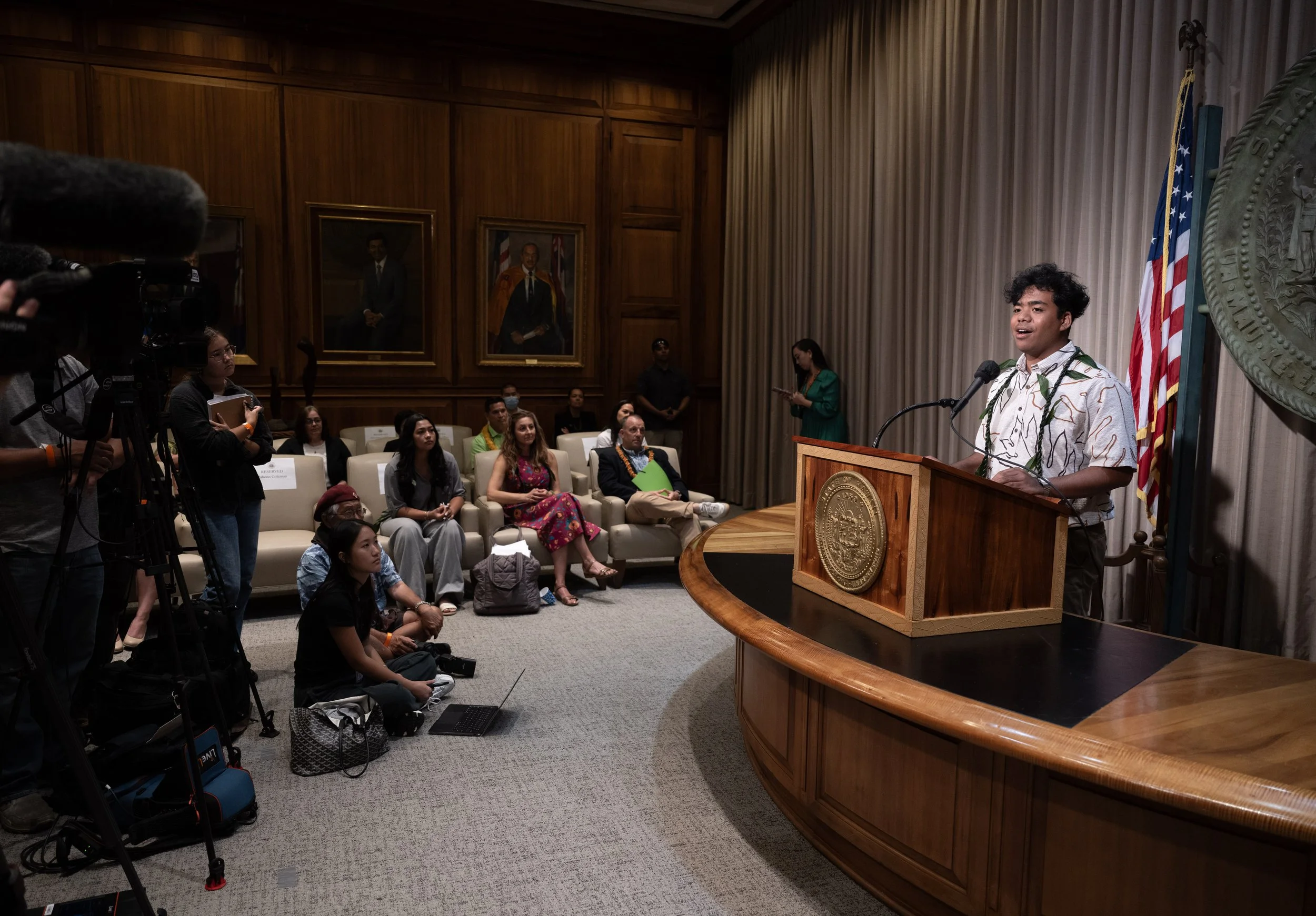Carrying the Spirit of Aloha: Pahonu’s Journey for Climate Justice in Hawai‘i
Pahonu C., youth plaintiff in Navahine v. Hawai‘i DOT at a joint press conference with Hawai‘i Governor Josh Green and HDOT Director Ed Sniffen announcing the first-of-its-kind Settlement Agreement. Photo by Robin Loznak
For Pahonu C., a Native Hawaiian youth plaintiff in the groundbreaking Navahine v. Hawai‘i Department of Transportation (HDOT lawsuit, climate justice is more than a fight—it’s a commitment to the land (‘āina), the community, and future generations. After achieving a historic Settlement Agreement with Hawaii’s government and HDOT, Pahonu reflects on the deep cultural values driving this work and the role young people play in shaping a sustainable future for Hawai‘i.
In this exclusive Q&A, Pahonu shares his passion for his cultural heritage, the challenges posed by climate change, and his hopes for how the Settlement Agreement will inspire Hawai‘i’s keiki (children) to continue advocating for their home and the planet.
What does it mean to you to be a Native Hawaiian?
To be Native Hawaiian, I think it means to belong to the ‘āina (land) and your community as well as your family. So, you have a responsibility to those people and to your place.
It's also practicing your culture and sharing aloha with others.
What do you love most about your culture and how has it been impacted by climate change?
One of my favorite things about my culture is probably our cultural practice of lei making, which is very famous here in Hawai‘i, and there has been a recent resurgence of people being interested in it. I think having access to flowers and your materials is very important.
What drives your passion for climate justice?
One of the major things that drives my passion for climate justice is seeing the positive impacts it's already having within systems and communities here in Hawai‘i.
How will the keiki (children) or kama'aina (people of Hawai‘i) in Hawai‘i carry the work of Navahine forward?
I think Navahine is becoming more than just a lawsuit. It's becoming a commitment for both young and old people.
I think Navahine for ka 'āina, the children of the land, it really supports them in becoming community contributors. Seeing people from their community and young people from their community, advocating at different levels, encourages them to get into the 'āina (land), to continue the work that they're doing. It’s also a commitment to ourselves and future generations.
What are you looking forward to the most in the settlement agreement process with the Hawai‘i Department of Transportation and the state?
Pahonu C. and his fellow Navahine v. Hawai‘i DOT youth plaintiffs. Photo by Robin Loznak
The two things that I'm really looking forward to are the establishment of the Hawai‘i Department of Transportation Youth Council, which directly allows keiki, or young people in general to be involved in the process and into the role of the council.
I'm also excited to see and learn about their greenhouse gas reduction plan. I think it's very important that we also recognize the creation of benchmarks for the settlement to ensure that both parties are keeping our promises.
What does a safe and livable climate look like to you?
A safe and livable climate looks like a place where people of all ages can safely interact with our environment, where food is accessible and it's a livable temperature.
How has working with Our Children's Trust impacted your life?
It was when they came to Hawai‘i that I was able to get to know them better and interact with them and have fun instead of just being in a meeting setting; it really showed me what OCT was about, which was building community relationships with young people here in Hawai‘i, and how their passion is intertwined.
What impact do you hope your work with Our Children's Trust will have on future generations?
I know for sure that the work that we've done with Navahine and the team at OCT will impact generations of generations of Native Hawaiians and communities here in Hawai‘i because I see it already happening.
For young people, I know that we've gained a sense of confidence in sharing our story within our families and our communities and throughout all of Hawai'i. And OCT was a very big part of that.
Why should people support Our Children's Trust?
People should support Our Children’s Trust to further their work and engage with young people like me in a positive way, and bridge generational gaps, too. In terms of the climate crisis, I think oftentimes we're working in our own silos, but Our Children’s Trust really fosters this multi-community and multi-generational approach to achieving climate justice.
Why are you proud to be a part of this community?
I'm proud to be a part of this community because we take action.




